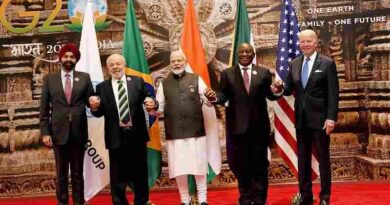Balancing Acts: Strategies to Counter China’s Debt-Trap Diplomacy
Introduction
In the realm of international relations, the intricate interplay of economic aid, geopolitical influence, and strategic interests has given rise to a phenomenon known as “debt trap diplomacy.”
This subtle but powerful strategy involves leveraging loans and financial assistance to gain economic and political leverage over recipient nations. One prominent player in this arena is China, a global economic powerhouse that has expanded its influence through an array of ambitious projects under the umbrella of the Belt and Road Initiative (BRI).
As China extends its financial reach, concerns about the implications of China’s debt trap diplomacy have intensified, igniting debates about the true nature of these economic relationships and their broader geopolitical ramifications.
What is Debt-Trap Diplomacy?
Debt Trap Diplomacy refers to a strategic approach in which a more powerful country extends loans and financial assistance to a less economically developed country to gain leverage, influence, or control over that country’s economic and political decisions.
This practice involves providing loans for infrastructure and development projects that the recipient country might not have the financial capacity to repay in the long term. As a result, the debtor country becomes increasingly dependent on the lender, often leading to a situation where the debtor’s economic and political sovereignty is compromised.
China’s Belt and Road Initiative (BRI) and Debt-Trap Concerns
China’s Belt and Road Initiative (BRI), launched in 2013, has been heralded as a monumental undertaking that aims to connect countries through vast infrastructure networks spanning Asia, Europe, Africa, and beyond.
However, behind the promise of enhanced connectivity and economic development lies a contentious issue: the debt trap concerns associated with BRI projects. Several Factors Contribute to these concerns:
Loans and Financing:
BRI projects are often financed through loans provided by Chinese state-owned banks or financial institutions. Some recipient countries have acquired substantial debt to fund these projects, leading to questions about their ability to repay these loans.
Financial Viability:
Some BRI projects have faced challenges in generating sufficient revenue to cover their costs, making it difficult for recipient countries to meet debt obligations. This can result in a situation where countries find themselves in debt distress.
Hidden Strings:
Concerns have been raised about the non-transparent terms and conditions attached to BRI loans. Some agreements reportedly include clauses that give China control over strategic assets if debt obligations are not met.
Impact on Sovereignty:
As countries struggle to repay loans, they may face pressure to align their policies and decisions with China’s interests. This can compromise their economic and political sovereignty, raising concerns about their ability to make independent choices.
Sustainability:
The long-term sustainability of BRI projects is a point of contention. If projects become economically unviable, they could lead to a cycle of debt accumulation and hinder a country’s overall economic development.
Case Studies: Debt-Trap Diplomacy
Several case studies have emerged that underscore the debt trap concerns associated with BRI:
Sri Lanka’s Hambantota Port:
One of the most prominent examples of debt trap diplomacy is Sri Lanka’s Hambantota Port. In 2010, Sri Lanka borrowed heavily from China to build the Hambantota Port, a strategically located deep-water port.
However, the port struggled to generate sufficient revenue to cover its operational costs and debt repayments. As a result, Sri Lanka found itself unable to service its debt to China.
In 2017, Sri Lanka was forced to sign a 99-year lease agreement with a Chinese state-owned company, effectively handing over control of the port to China.
This raised concerns about China gaining a strategic foothold in the Indian Ocean region and raised questions about the implications for Sri Lanka’s sovereignty.
Djibouti’s Doraleh Port:
Djibouti provides another example of debt-trap diplomacy. The small African nation took on significant debt from China to develop the Doraleh Port, a key gateway for trade in the Horn of Africa.
However, when Djibouti faced challenges in repaying the debt, China’s state-owned enterprises took control of the port through a 66% stake in the port operator.
This case raised concerns about China’s expanding influence in Africa and the potential for Chinese-controlled infrastructure to have implications for regional security and trade dynamics.
Pakistan’s Economic Challenges:
While not limited to a single project, Pakistan’s experience with debt trap concerns is illustrative. Pakistan has received substantial loans and investment from China for various infrastructure projects, including the China-Pakistan Economic Corridor (CPEC).
However, concerns have arisen about the financial viability of these projects and Pakistan’s ability to repay its debt obligations.
Pakistan’s debt to China has contributed to its economic challenges and raised questions about the long-term implications of the debt burden on the country’s sovereignty and economic independence.
Montenegro’s Highway Debt:
In Europe, Montenegro’s experience with debt-related agreements has drawn attention. Montenegro borrowed heavily from China to fund a highway project, which was part of the country’s efforts to enhance connectivity.
However, concerns arose about the feasibility of the project and its economic viability. As Montenegro struggled to repay the loans, there were debates about whether the country could be susceptible to China’s influence due to its indebtedness.
Kenya’s Standard Gauge Railway:
Kenya’s involvement with Chinese-funded projects also offers insights. The country secured loans from China to build the Standard Gauge Railway (SGR), a major railway connecting Nairobi to the port city of Mombasa.
While the project aimed to modernize Kenya’s transportation infrastructure, concerns emerged about the cost of the project and its economic benefits. Critics raised questions about the transparency of the loan agreements and the potential for Kenya to fall into a debt trap.
Laos’ Debt Challenges:
Laos provides an example from Southeast Asia. The country faced difficulties servicing its external debt, much of which was tied to infrastructure projects funded by China.
As a result, Laos had to cede control of a majority stake in its national power grid to China’s state-owned enterprises. This case highlighted the potential consequences of unsustainable debt and the trade-offs countries might face when dealing with large foreign loans.
Venezuela’s Debt to China:
Venezuela, struggling with economic instability, turned to China for financial assistance. In exchange for oil supply agreements, China provided loans to Venezuela.
As Venezuela’s economic situation worsened, it faced challenges repaying these loans. China’s influence over Venezuela’s oil resources raised concerns about the potential loss of sovereignty and control over vital national assets.
Papua New Guinea’s Infrastructure Projects:
Papua New Guinea (PNG) is engaged in infrastructure projects financed by Chinese loans. The PNG government faced scrutiny over the transparency of loan terms and the potential for debt trap diplomacy. Concerns were raised about the economic viability of certain projects, the capacity to repay loans, and the implications of default.
Myanmar’s Kyaukpyu Port:
Myanmar’s Kyaukpyu Port is a strategic asset in the Bay of Bengal, and China invested in the port’s development as part of the China-Myanmar Economic Corridor. While the project aimed to enhance trade connectivity, concerns emerged about the large-scale debt associated with the project and its potential impact on Myanmar’s sovereignty.
Maldives’ Debt and Strategic Assets:
The Maldives experienced political and economic shifts that led to concerns about its ability to manage debt. China’s involvement in funding infrastructure projects, such as the expansion of the Velana International Airport, raised questions about the potential implications for the Maldives’ sovereignty and its ability to maintain control over strategic assets.
Debt-Trap Diplomacy: Addressing the Issue
Addressing the issue of debt trap diplomacy requires a comprehensive and cooperative approach that involves not only the borrowing countries but also lenders, international organizations, and the global community.
Transparency and Responsible Lending Practices:
Lenders should ensure transparency in loan agreements, terms, and conditions, allowing borrowing countries to make informed decisions.
Encourage responsible lending practices that consider the borrowing country’s economic capacity and long-term sustainability.
Capacity Building and Due Diligence:
Borrowing countries should enhance their capacity to assess and negotiate loan agreements effectively, conducting rigorous feasibility studies and cost-benefit analyses for proposed projects.
International Financial Institutions’ Role:
International financial institutions like the International Monetary Fund (IMF) should provide technical assistance and expertise to help countries evaluate the economic viability of projects and manage debt.
Global Debt Sustainability Framework:
Develop a global framework for debt sustainability that sets clear guidelines and standards for lending practices to ensure that loans contribute to a country’s development rather than causing instability.
Debt Restructuring Mechanisms:
Establish mechanisms for orderly debt restructuring that involve negotiations between borrowers and lenders, allowing for adjustments in terms without causing economic crises.
Coordination Among Borrowing Countries:
Borrowing countries can collaborate to share experiences, information, and best practices, enabling them to negotiate better terms collectively and strengthen their bargaining power.
Regional and Bilateral Cooperation:
Strengthen regional cooperation and bilateral partnerships to collectively address debt-related challenges and work towards sustainable solutions.
Responsible Project Selection:
Prioritize projects that align with national development goals, ensure economic viability, and have a positive impact on the country’s long-term growth prospects.
Public Awareness and Participation:
Engage citizens in discussions about major projects and their financing, promoting transparency and accountability in decision-making processes.
Multilateral Diplomacy:
Engage in multilateral dialogues and negotiations to address debt trap diplomacy collectively, fostering a more balanced and equitable global economic environment.
Sustainable Development Goals (SDGs):
Ensure that infrastructure projects align with the United Nations Sustainable Development Goals, focusing on projects that contribute to economic growth, poverty reduction, and social well-being.
Inclusive Growth and Poverty Alleviation:
Prioritize projects that directly benefit local communities, create jobs, and contribute to poverty alleviation, promoting inclusive and sustainable growth.
Alternative Financing Mechanisms:
Explore alternative financing mechanisms, such as public-private partnerships, concessional loans, and grants, to diversify funding sources and reduce dependency on high-interest loans.
Final Takeaway
In the intricate web of international relations and economic dynamics, the concept of debt-trap diplomacy stands as a cautionary tale for nations seeking progress through financial assistance.
As we traverse the narratives of various case studies and delve into the mechanisms and implications, it becomes abundantly clear that the pursuit of development must be accompanied by a keen awareness of potential pitfalls.
The examples of Sri Lanka’s Hambantota Port, Djibouti’s Doraleh Port, and other instances vividly illustrate the multifaceted challenges of debt-trap diplomacy.
Beyond the allure of immediate infrastructure growth lie concerns of sovereignty compromise, economic vulnerability, and even geopolitical realignment.
These cautionary tales offer valuable insights for nations considering similar ventures, emphasizing the imperative to approach foreign loans with meticulous planning, transparency, and foresight.



